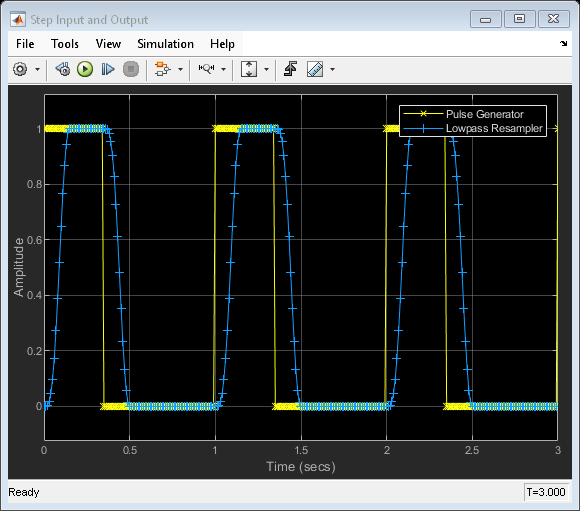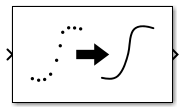Lowpass Resampler
Libraries:
Mixed-Signal Blockset /
Utilities
Description
The Lowpass Resampler block converts either a fixed-step discrete or a variable-step discrete sample time at its input to a different sample time at its output. To calculate the output sample values, the block uses a lowpass filtering interpolation algorithm. The algorithm minimizes frequency aliasing at the output with respect to an output rise/fall time.
If the output rise/fall time is inherited from a fixed-step discrete input, the cutoff frequency is the Nyquist rate of the input. Otherwise, the cutoff frequency is the Nyquist rate associated with a sample interval obtained by scaling the specified 20%−80% output rise/fall time to a value for 0%−100% rise/fall time.
Examples
To demonstrate the variable step discrete behavior of the Lowpass Resampler block, open the model LowpassResamplerOutputSampling.
model = 'LowpassResamplerOutputSampling';
open_system(model)

The model consists of a Pulse Generator and a Lowpass Resampler. The pulse generator generates a pulse of 1 Hz with a duty cycle of 35%. The Pulse type is selected as Time based. In the Lowpass Resampler, the Output rise/fall time is set to 0.05 s, the Number of samples of delay is set to 1, the Output sample time is set to Variable step discrete, and Samples out per rise/fall time is set to 5.
In the Model Settings, the Max step size of the solver is set to 3, the simulation stop time. As a result, the only sample times are those generated by the model and the sample time display is readily understandable.
Run the simulation.
sim(model)
ans =
Simulink.SimulationOutput:
tout: [97x1 double]
SimulationMetadata: [1x1 Simulink.SimulationMetadata]
ErrorMessage: [0x0 char]

To demonstrate the fixed step discrete behavior of the Lowpass Resampler block, set the Output sample time is set to Fixed step discrete. Rerun the simulation and observe the additional samples produced by the model.
set_param([model '/Lowpass Resampler'],'OutputTsType','Fixed step discrete'); sim(model)
ans =
Simulink.SimulationOutput:
tout: [301x1 double]
SimulationMetadata: [1x1 Simulink.SimulationMetadata]
ErrorMessage: [0x0 char]

Ports
Input
Discrete time input signal, specified as fixed-step or variable-step scalar.
Data Types: single | double | int8 | int16 | int32 | uint8 | uint16 | uint32 | Boolean
Output
Continuous time output signal, returned as a fixed-step or variable-step scalar.
Data Types: single | double
Parameters
Select to inherit the output rise/fall time from the fixed-step input sample time.
Note
In case of variable step input, there is no rise/fall time to inherit.
20%−80% output rise/fall time, specified as a positive real scalar.
Dependencies
To enable this parameter, deselect the Inherit output rise/fall time parameter.
Programmatic Use
Block parameter:
OutputRiseFall |
| Type: character vector |
| Values: positive real scalar |
Default:
1e-10 |
Number of samples of propagation delay for fixed-step operation, specified as a positive real scalar.
If the Lowpass Resampler block inherits Output rise/fall time in fixed-step mode, the resampler conversion delay is given by NDelay·τ, where NDelay is the Number of samples of delay parameter and τ is the inherited input sample interval.
In the variable-step input mode, the resampler conversion delay is given by 0.6τv when NDelay equals to one, and is (NDelay-0.5)·τv when NDelay is greater than one. τv is 5/3 times the Output rise/fall time parameter.
There is a tradeoff between the delay of the conversion and the suppression of out-of-band numerical artifacts, with greater delay producing better fidelity in band and greater suppression out-of-band.
Note
If you need anti-aliasing filter rejection, set Number of samples of delay to 5 or higher.
Dependencies
To enable this parameter, deselect the Inherit output rise/fall time parameter.
Programmatic Use
Block parameter:
NDelay |
| Type: character vector |
| Values: positive real scalar |
Default:
1 |
Type of the output sample time to be used by downstream blocks, specified as either fixed step discrete or variable step discrete. The output sampling rate must be higher than the input sampling rate. For more information, see Variable Step Sampling Scheme.
Programmatic Use
Block parameter:
OutputTsType |
| Type: character vector |
Values:
Fixed step discrete | Variable step
discrete |
Default:
Inherited |
Number of output samples in a single output rise/fall time, specified as a positive real scalar.
Dependencies
To enable this parameter, select the option Fixed step
discrete or Variable step discrete in the
Output sample time parameter.
Programmatic Use
Block parameter:
OutputTsRatio |
| Type: character vector |
| Values: positive real scalar |
Default:
5 |
Select to enable extra buffer samples. This option is enabled by default.
Number of extra buffer samples needed to support the number of samples of delay, specified as a positive real scalar.
Programmatic Use
Block parameter:
NBuffer |
| Type: character vector |
| Values: positive real scalar |
Default:
10 |
More About
The Lowpass Resampler block interpolates the incoming discrete signal using an anti-aliasing filter. The anti-aliasing filter introduces some delay and the suppression of outputs above the specified signal bandwidth is not perfect. Introducing larger delays produces better fidelity in band and greater suppression out-of-band at the cost of more delay inserted in the signal path. In all cases, the interpolation filter is designed to produce negligible group delay distortion in-band.

In the time domain, the interpolation does introduce some ringing in the step response
of the anti-aliasing filter, which could affect some digital switching applications.
However, the choice of Number of samples of delay parameter of
1 and Output rise/fall time parameter greater than
zero is specifically designed to produce a smooth waveform transition with no
ringing.

In some cases, it might be necessary for the Lowpass Resampler block to define its own sample time. This is particularly true if the block receives an unspecified output sample time at its input.
If the Lowpass Resampler block receives a signal that changes its value at the input, the block generates some output samples to show the transition. The number of samples are defined by the Samples out per rise/fall time parameter.

Version History
Introduced in R2021aLowpass Resampler can define its own output sample times.
Use to change the sampling time of a signal.
MATLAB Command
You clicked a link that corresponds to this MATLAB command:
Run the command by entering it in the MATLAB Command Window. Web browsers do not support MATLAB commands.
웹사이트 선택
번역된 콘텐츠를 보고 지역별 이벤트와 혜택을 살펴보려면 웹사이트를 선택하십시오. 현재 계신 지역에 따라 다음 웹사이트를 권장합니다:
또한 다음 목록에서 웹사이트를 선택하실 수도 있습니다.
사이트 성능 최적화 방법
최고의 사이트 성능을 위해 중국 사이트(중국어 또는 영어)를 선택하십시오. 현재 계신 지역에서는 다른 국가의 MathWorks 사이트 방문이 최적화되지 않았습니다.
미주
- América Latina (Español)
- Canada (English)
- United States (English)
유럽
- Belgium (English)
- Denmark (English)
- Deutschland (Deutsch)
- España (Español)
- Finland (English)
- France (Français)
- Ireland (English)
- Italia (Italiano)
- Luxembourg (English)
- Netherlands (English)
- Norway (English)
- Österreich (Deutsch)
- Portugal (English)
- Sweden (English)
- Switzerland
- United Kingdom (English)
